Editorial
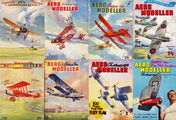
Once again, a very non-denominational Merry or Happy mumble to all of you and yours! The December issue of MEN has always been a "Bumper" issue because that's what the December issue of Aeromodeller was back when I was acquiring my diesel habit (and back to when I was born, come to that). It was part of the excitement of Christmas, which I hope this issue manages to convey in its small way. For those in the US, I've put together a montage of some of the December covers to show what I mean—they were always eagerly awaited by we young lads and read until the covers fell off. For readers in the old Commonwealth countries, I hope they bring back fond memories too. I don't know if this use of "bumper" is ethno-centric, or not. One on-line dictionary defines usage in this context as meaning "unusually large", but with the wonderful Internet, you can find a reference that seems to support just about any cock-eyed theory if you try hard enough. But for the December MEN, let's all understand it means larger than normal, with a free plan for Members. Woohoo.
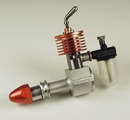
In selecting a subject for the past December MEN free plans, I've tried to cover the full spectrum of IC engine types, even going to an air-driven radial with the Westbury Cygnet Royal. Having done this, what next? After some thinking, I selected the Clanford Clan as an example of a sub-miniature 0.015 cuin diesel. I always consider rather carefully the morality of releasing a full construction plan for an engine which was a past commercial product and which now commands a high price on the second-hand market. The Motor Boys mulled this one over years ago, knowing that there are unscrupulous types lurking out there, ready to work a scam when they can. My justification on the Clanford Clan is the tank top. On original engines, this was a black plastic injection moulding. That's a bit hard to fake and if anyone actually did replicate it, he's just moved from scammer to genuine reproduction maker and deserves some return! So enjoy the little Clanford Clan, but be warned, despite the fact it's tiny and can be made from scrap, this is not a beginners' engine! The piston/liner fit and alignment must be first-class if it's going to run, which many originals did not, but that's another story...
For the rest of our Bumper edition, we have at least one of just about everything and two of some; a Watzit, some Gallery entries, more People information, a very comprehensive review of some under 1cc engines by Adrian Duncan, a giant Soviet marine diesel by David Owen, and some new and updated mini-reviews from yours truly. Rather than list them all, I'll just remind you that during the month of December 2010, the New and Updated Index page will show you what needs to be looked at, as does the Engine Finder.
On the home front, I got along to the Brisbane SMEE demo day and saw some fine model IC work done by members, both aero and stationary. Of course there was a lot of big-iron live-steam demos and action as well. I truely have to take my hat off to any model engineer who decide to build something they know that they are going to need a fork-lift to transport to and from the track, and complete it! In the UK, there's been a big resurgence of 2-1/2 gauge and I must wonder if being able to pick it up by yourself has something to do with it. Anyway, I'm waiting on photos from others because although I charged the camera batteries, I forgot to put a memory card in it. A stronger statement about the joys of getting old I cannot make...
David Owen's 2010: An Engine Odyssey

Earlier this year, David and Celia Owen decided to take a trip through the UK and parts of Europe. David is a founder Motor Boy and designer of the highly successful "Mate" 2cc DIY diesel, and Grande Fromage at Owen Engines Australia. During their eight weeks away, David and Celia visited a number of old friends as well as some whom they knew only through earlier correspondence. All of these people are well-known aeromodellers and most have been involved with engines, either as builders, manufacturers, or collectors—some still are! David says it was a tremendous privilege to meet and talk to people on the other side of the world who shared not only a passion for our hobby, but who in many cases could be considered as acknowledged experts in the field of model engines.
With almost no arm-twisting at all, David has provided us with photos and an account of their trip. We hope readers will enjoy this both as a diversion from our usual dry fare, and as an opportunity to put actual faces to names which many will instantly recognize. As the Old Bloke is getting on and types slower than he used to (not to mention, really should be out in the shop completing those Taipan Replicas  ), the Odyssey has been divided into two parts: England and Europe. This month we present the first part with the second scheduled for our January 2011 issue. Enjoy!
), the Odyssey has been divided into two parts: England and Europe. This month we present the first part with the second scheduled for our January 2011 issue. Enjoy!
Reach out
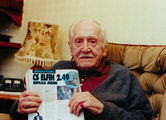
One of the real pleasures of creating all these pages is receiving word from people who have found genuine pleasure in them. Mostly this comes from model engineers and model engine enthusiasts, but not always. Last month, our page dedicated to Frank Ellis and his Elfin engines was found by his daughter, Patricia (Trixie) Ellis Wadell. In short order Trixie had notified other family members and arranged for some pictures of Frank to be sent. These have now been added to the page and we are really grateful to the Ellis family members as pictures of people like Frank are hard to obtain from our usual sources and really liven up the page, adding some humanity that mere engine pictures cannot provide. Trixie also mentioned that as well as being the designer and driving force behind Aerol, Frank was the father of 12 children. Makes his achievements all the more impressive, somehow.
MAN 19 Under Way
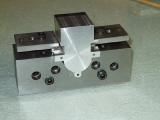
What I'd rather hoped for when presenting the old Martin MAN 19 has happened. Charlie Stone (WA Australia) has started cutting metal and knowing his work, a fine example of the engine will follow in the fullness of time. Of particular interest here is the fixture Charlie has made to hold his roughed out case while he bores out for the front and rear ball races. Charlie wrote that he initially had trouble sourcing the right class of ball bearing until rescued by Steve Rothwell of SMR Precision, home of the fabulous Rothwell Oliver Tiger replicas. The front bearing Steve has supplied is the same size as that originally specified by Ted Martin, while the rear has a 0.125" smaller outside diameter (OD), so it will be easily accommodated in the case dimensions. I really look forward to seeing Charlie's completed case.
Dragonfleas
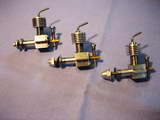
A slightly more complicated cousin the our December free-plan for the side-port Clanford Clan is the RRV Dragonflea, adapted from the small production Dragonfly engine of 1961. Our MAN plan for this engine (in two displacement of .1cc and .2cc) has been used as the basis for development work undertaken by Norman Fellows (UK). Norman made a few design changes and altered the timing, reducing the 180° inlet duration by 50° and slightly decreasing exhaust and transfer. His three 0.15cc examples are all fine runners on a 5x3 prop using 40% ether fuel (small diesels like a bit extra ether). Norman presented one of his 'fleas to Mike Parker who wrote it up in his Power Struggle column in the December 2010 edition of SAM 35 Speaks. It's really great seeing my plans being turned into running engines. The reduced inlet duration will help make it a bit less critical for starting and tuning. The reductions in exhaust and transfer are only a few degrees and are within what would be allowed for with acceptable tolerance for port cutting and deck height. The trick, as always with engines of this size, is keeping friction low and obtaining excellent piston/liner fits. Norman is obviously expert at this. Well done!
Kiwi School Project
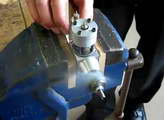
In Australia, we have a very long running weekly radio program on science, called, appropriately enough, The Science Show, and hosted by one Robyn Williams. Depending on you perspective I could say "not that Robyn Williams", or "yes, that Robyn Williams". It's pod-cast, so if you want to listen regardless of wherever you are, use the link and troll around. To me as a computer scientist in the engineering faculty, an depressingly frequent comment on the show is the increasing difficulty of fostering an interest in science at high school (maths is hard) and at university (lawyers are better paid). So I was really pleased to get an email from Ian Munroe of the NaeNae College, New Zealand. We've talked about Ian's work before. This year, the subject was a glow plug engine with an air-bleed carby activated by rotating the fuel tank. Porting keeps the RPM down in the 2-5K range and from the youTube videos, the students have learnt a lot and had a ball.
Ian reports that one student from last year is now doing an engineering degree course in Wellington, while a girl from the year is doing marine engineering in Auckland. Ian's best student from this year has just got a $4000 scholarship to do engineering next year. With the problems being reported from all over the Western world that will see the number of scientists and engineers steadily decline, this is an outstanding achievement fostered by home built model airplane engines. Who said they're just smelly, noisy things? You can watch two YouTube videos of this year's student engines in action here, and here.
That Twin from Fig Tree Pocket, again

Creating a model engine drawing set, even a small one, is not a quick task. Shift the decimal point one place to the right when it's a twin of some sort. Never the less, I had a fine time turning Russell Watson-Will's original sketched for his Fig Tree Pocket Twin into CAD sheets, even if I did secretly suspect that the plans would be more looked at than built from. Just shows you should never take any stock tips from me; that twin has been reproduced an amazing number of times and if you click through to Page 16 of the Gallery, you can see the latest one completed.
Watzit on the Wing
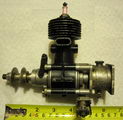
Our Watzit this month is not that difficult, although it's more likely to be identified by model engineers than aeromodellers. And even if you can instantly say to which "family" it belongs, can you tell whether it's the 10cc or 7.5cc model just be inspection of the photo? If you can, you should be writing this column, not me—although I knew I knew it, I had to draw on the collective wisdom of the Motor Boys before sending the definitive "its-a" email back to the reader who sent the photo. Won't forget it again, though. Click the thumbnail, or get lost in the Watzit Index page.
Yulon!
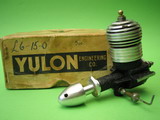
I've wanted to feature the old Yulon for ages, but lacked actual photos. This situation was remedied during the past month by a reader who has just obtained a NIB example of the Yulon 29. This engine, along with the earlier .30 and later .49 were very successful on the British C/L stunt competition circuit around 1949/50, in part because of their extreme light weight. In researching the engine in The Library collection, I was surprised to find the plan for a stunter by Brian Hewitt called the Stunt King which featured strongly in contest wins of the time. From looking at it, I guess judges were buying fast and loud that year. I'd like a Yulon, but would have to travel far out into the country to run it. A muffler could be fitted, but that sort of defeats the whole Joy of Yulon experience. Read the Yulon review and you'll see why, and find where the name came from.
Engine Of The Month: Under 1cc FROGs
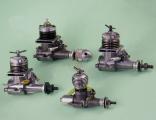
For this issue, Adrian Duncan follows on with his analysis of British 049 glows. This not-really series begun some time back with the KK Cobra and continued last month with the DC Bantam 049. The next major player in this cycle is International Model Aircraft (IMA) and if that name rings no bells, they invented the plastic model kit in 1937 under the name "Penguin" and released flying model kits and accessories under the name "FROG". But it would be impolite to simply consider the FROG 049 glow without examining its predecessors, the FROG 50 and FROG 80, so this month's Engine of the Month covers all of IMA's under 1cc offerings, including the Venom 049. Now if you think this is a mistake and that the FROG Venom was the glow version of the rather nice 1.5cc FROG Viper, you better read the article to find out how Hefin Davies got into the picture and confused things for all time.
New Books and Magazines This Month

Last month, in mentioning the passing of modelling legend, Ron Moulton, we listed some of his extensive publications, including the Model Aero Engine Encycolpaedia, to give it the British spelling, as opposed to the Micky Mouse Club spelling which I got in trouble for using in primary school. As this work is right up our street, and since The Library received nothing of note in the past month, let's take a look at a book first published in March, 1958.
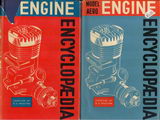
The Model Aero Encyclopaedia, Argus Press Ltd, London EC4, no ISBN, credits Ron Moulton as the "Compiler". This is quite appropriate as it is composed in the most part of material which had previously appeared in Aeromodeller magazine from people like EF Brauner, Pete Buskell, Fred Carter, Fredrick Marshall, EC "Ted" Martin, S/Ldr Sholto-Douglas, Dave Sugden, and Ron Warring. Notice how many of these already are mentioned in these pages. Of the remaining two, while I've no idea about the good Squadron Leader, I've certainly mentioned Brauner over the years in emails relating to pulse jets. Anyway, it's the work of these gentlemen that Ron Moulton "collected" and organized into this book. The organization is not alphabetical, but it still qualifies as an "encyclopaedia" being a reference work dealing with a particular branch of knowledge. The book (let's call it the MAEE for short), is cloth bound, 5-1/2x8-1/2, with 208 pages, profusely illustrated with excellent black and white illustrations and photographs. It is organized into two sections comprising twenty-seven chapters, plus appendices.
First let me dispel any misconception. While almost everything in the MAEE had appeared in the pages of the Aeromodeller, the book is not a mere reprint collection. As Assistant Editor, then Editor of that revered magazine, RGM had access to all of the original artwork, text, and photos. These he has reordered, edited and renumbered as required into a logical and well thought out structure which covers everything an aeromodeller of the 50's and 60's needed to know about model engines. In fact, modern modellers will find almost all of the material remains relevant. About the only chapter which technology and time have made totally obsolete is Chapter 16 Engine Speed Controls, though it's amusing to see the wondrous devices modellers resorted to before the standard, boring old R/C carby became wide-spread (ok, so the vibrating reed rev-counter may be a bit dated as well  ).
).
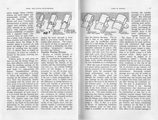
In the first section of the book, RGM presents eighteen chapters covering all the basics of how model two-strokes work, what types exist, how they are constructed, what fuels are used, etc—all the usual suspects. The illustrations are very clear and informative, reflecting Aeromodeller's distinct house drafting style. The example chosen here shows the popular cylinder porting styles, related to engine manufacturers of the time. Having read this, any modeller would be well informed on the differences and relative advantages. Naturally starting, fuel tanks and prop selection are all covered in detail. Being British, more attention is paid to diesels than glow and spark ignition engines, though they do get good coverage too.
Part II is titled, Making Your Own Engine and contains a reprint of Dave Sugden's Sugden Special series which had been serialized in the magazine in 1955. Although reduced in size somewhat, the text has been reset to fit the MAEE format with some illustrations moved about. Following the Sugden is the Brauner pulse jet plans which too had appeared in the Aeromodeller. Part II concludes with the most Heath-Robinson, on-board rev-counter ever conceived. No, I'm not going to describe it, you would not believe me.
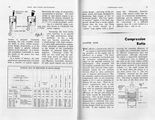
Between 1958 and 1971, the MAEE went through at least seven printings and revisions. There may be more as I'm going on the 1971 edition print history. For this review, I've consulted the 1959 and 1971 editions and found some non-trivial differences. For the most part, these are constrained to the Appendices, but there are some differences in both text and photographs. In particular, the chapter on glow engines is completely changed in the '71 edition, indicating that RGM was keeping up with developments in the USA. Although all editions from the first devote a chapter to silencers (mufflers), the '71 edition adds an extra four pages in the Appendices to "The Need for Silencers", surely an indication of changing times. The '71 edition also contains two pages labelled "17 Years of Aeromodeller Engine Analysis" listing all engines reviewed by Sparey and Warring from 1948 to 1964, with the month in which the review appeared in Aeromodeller and the peak BHP/RPM figure the reviewer found. Apples and oranges really, given how Warring cast suspicion of the "earlier apparatus" used by his predecessor. In place of this in the 1959 edition we have capsule reviews of select British and American engines in a format similar to that used in the Aeromodeller Annual. Both contain a table called "World's Engines (excluding Soviet Union)" which runs to three pages but uses a much smaller font in the later edition.
It's a bit pointless to review out of print works, so before commencing this review, I checked The Advanced Book Exchange web site and found six copies on offer, all priced in the $65 range; four in England and one each in Australia and the USA. So it you want a copy, it's not all that difficult. As a reference work, the MAEE would be of most interest to beginners, historians, and those who like looking back to nostalgic times through the illustrations and photos. I still have occasion to refer to both my copies and often get sucked into looking at something in them quite foreign to what I started looking for. My rating—no surprise I think—is the full Five Stars  , missing the Gold Star and Koala Stamp only because of that rev-counter!
, missing the Gold Star and Koala Stamp only because of that rev-counter!
Tech Tip of the Month
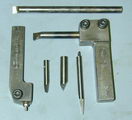
The sort of work model engineers undertake, especially those building IC engines, frequently requires some rather small and unusual shaped tooling. The use of round stock for specialized jobs and appropriate holders for these was brilliantly described by George H Thomas in the Model Engineer. Luckily for those not cursed with sagging shelves full of old ME issues, the GHT Model Engineers' Workshop Manual, a Five-Star selection, reprints just about everything he wrote for the magazine except his Universal Pillar Tool and Universal Dividing Head which became books in their own right. Seen here are two GHT style holders for 3/16" and 1/4" HSS round tooling. The long boring bar and internal thread cutter mounted in the holder are actually 1/4" drill rod with a piece of 1/4" square HSS tool steel silver brazed to the end and ground to shape. One advantage which may not immediately be obvious for this tooling is the ability of the holder to be used on the grinding wheel table to quite accurately set angles while off-hand grinding: tool-holder and jig combined! The tools seen here were made in my very early days in this hobby and have been used on every engine I've built (about 80, last rough count). I don't call them useful; they are indispensible!
Purdy Humbug
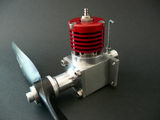
This Humbug was completed last month by Kiwi member, Ross Purdy. With my almost uncontrollable penchant for bad puns, I was tempted to make a cryptic comment related to the obvious attractiveness of the engine, but finally saw sense. Instead, I draw your attention to the nicely composed and lit photograph, the clean plunge knurling evident on the edge of the prop-driver, and the superb home anodizing job on the cylinder jacket. Ross and his son, Hayden, dropped in here for a visit while holidaying in Oz recently. Hayden has put together a really professional video of the Humbug being run, along with Ross' rendition of my MEB Mills 1.3 Mk I, and a Sparey .8 (sic). His effort can be seen here on YouTube and is more than worth the bandwidth.
 David Owen's 2010: An Engine Odyssey
David Owen's 2010: An Engine Odyssey
 Reach out
Reach out
 MAN 19 Under Way
MAN 19 Under Way
 Dragonfleas
Dragonfleas
 Kiwi School Project
Kiwi School Project
 That Twin from Fig Tree Pocket, again
That Twin from Fig Tree Pocket, again
 Watzit on the Wing
Watzit on the Wing
 Yulon!
Yulon!
 Purdy Humbug
Purdy Humbug
 Editorial
Editorial
 New Books and Magazines This Month
New Books and Magazines This Month
 Engine Of The Month: Under 1cc FROGs
Engine Of The Month: Under 1cc FROGs
 Tech Tip of the Month
Tech Tip of the Month
 Standard Stuff
Standard Stuff




 ), the Odyssey has been divided into two parts:
), the Odyssey has been divided into two parts: 











 , missing the Gold Star and Koala Stamp only because of that rev-counter!
, missing the Gold Star and Koala Stamp only because of that rev-counter!

